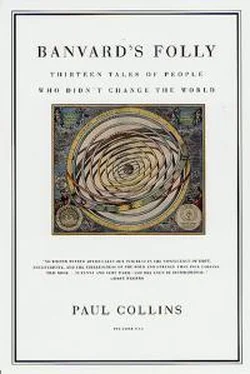When James Boswell, the biographer of Samuel Johnson, stopped in, he was so overcome with emotion at the sight of the papers that he could only recover with the aid of a tumbler of warm brandy and water--which, in truth, he might have asked for even were he not overcome with emotion. Finishing off his brandy, he pulled himself from his chair and declared, "Well, I shall now die contented, since I have lived to witness the present day." A few months later he most obligingly made good on this promise.
The praise of Britain's elite fired William's imagination; even as Samuel shone in the reflected glory of the Shakespeare papers, William watched from outside his father's study and alone knew who the real literary genius was.
Soon his promises to his father became more and more ambitious, even rash.
--I've found a handwritten manuscript of King Lear, he said one day.
He had been hard at work on this for some time. But it was not a mere transcription of King Lear from the published editions. William decided he was going to improve on the original. It was a typical impulse for his time; eighteenth-century theaters were infamous for removing unseemly humor in Shakespeare tragedies, or excising tragic moments from comedies. And since Georgians dearly wished their Bard could be more refined in his tastes, William replaced Shakespeare's lines with improved versions that removed any earthy humor.
Samuel and a throng of experts were delighted, and William topped it off by discovering books from Shakespeare's library--volumes which, had anyone noticed, looked suspiciously similar to ones for sale the previous week on Charing Cross, but which now bore the great poet's comments in the margins.
In churning out a blizzard of false documents, William developed a steady forged handwriting in which he could write as assuredly as in his natural hand. But as he set about writing his next discovery, a manuscript of Hamlet-or "Hamblette," as he had renamed it in a bizarre attempt at archaic spelling--he was getting restless. He no longer wanted to merely invent legal documents and improve on famous plays. He wanted something more.
One day, between visits from the famous and the merely curious, William sat alone in his father's study on Norfolk Street. In a display case he could see the rapidly growing pile of Shakespeare papers; none, though, had given him a chance to exercise his own literary talents. As he brooded and looked about the room, his eye fell upon a picture hanging over the fireplace: a painting of King Vortigern, an infamously ruthless king of fifth-century Britain. Now here, William reflected, was a subject worthy of a Shakespeare play. He pulled down his father's old copy of Raphael Holinshed's Chronicles (1577)--the same account Shakespeare relied on when writing his history plays.
Holinshed portrayed King Vortigern as a rather nasty piece of work. He had no claim on the throne, but served as the scheming adviser to a simple-minded heir:
Ye have heard how Constantius was made a moonke in his fathers life time, bicause he thought to be too soft and childish in wit, to have anie publike rule committed to his hands: but for that cause speciallie did Vortigerne seeke t'advance him, to the end that the king being not able to governe of
himselfe, he might have the chiefest swaie, and so rule all things as it were under him.
Hidden behind this legitimate heir, Vortigern sowed discord amongst his enemies and rivals, and sent innocent men to the gallows. When Constantius was no longer of any use to him, Vortigern simply had him murdered and seized the throne. Still married, he announced his intention of taking a second wife, who promptly attempted to poison him; he was then overthrown by Constantius's legitimate heirs and by citizens disgusted with the usurper's murderous debauchery.
After reading Holinshed, William proudly announced to his father the discovery of an entire original play by Shakespeare: Vortigern. His father was so delighted that he badgered William about it every day. William, writing as fast as he could in the unsafe sanctuary of his workplace--one morning the cleaning lady burst in on him in mid-forgery--had to keep stalling Samuel. Mr.
H, he explained, was transcribing his own copy before allowing it to leave the mansion.
It took William two months to finish the play. When he presented it to Samuel in late March 1795, his father did something unusual--he wouldn't let anyone else see it. This play, Samuel knew, was pure gold. He quietly began inquiring at some of London's biggest theaters: might they be interested in staging Shakespeare's lost play?
Producers offered Samuel contracts for Vortigern sight unseen. But the most prestigious to rise to the bait was Robert Brinsley Sheridan of the Theatre Royal on Drury Lane--the most prominent producer and playwright in London, and a member of Parliament to boot. But after reading the first few pages, with Samuel looking on, Sheridan's ardor cooled a bit: "There are certainly some bold ideas here, but they are crude and undigested. It is very odd: one would be led to think that Shakespeare must have been very young when he wrote the play." Lest Samuel become alarmed, Sheridan then added, "As to the doubting whether it is his or not, who can possibly look at the papers and not believe them ancient?"
Samuel wanted l500. Sheridan, knowing that he could not back out of the deal now, sensibly haggled him down to l250. He felt it was simply a mediocre Shakespeare play; few people questioned the authenticity of the papers. Why would they? The paper was real enough, as were the seals. And everyone knew that William Ireland wasn't clever enough to write well in his own modern tongue, never mind forge a document in Elizabethan English. They would have been right on the last count, if only they could see it. William couldn't forge a document in Elizabethan English, as his love letter to Anne Hathaway demonstrates:
O Anna doe I love doe I cheryshe thee inne mye hearte forre thou arte as a talle Cedarre stretchynge for the its branches ande succourynge smaller Plants fromme nyppynge Winneterre orr the boysterouse Wyndes Farewelle toe Morrowe bye tymes I wille see thee tille thenne Adewe sweete Love This was the work of an ambitious but inexperienced youth who mimicked old writing by arbitrary additions of double consonants, replacing i with y, and tacking e at the end of words. It wasn't Elizabethan dialect.
It wasn't any dialect.
There is a truism among museum curators that the best forgeries are the ones still hanging on the walls. Any example of forgery is necessarily an example of a flawed forgery, because it is known to be a forgery. The best forgeries
are beyond reproach in their authenticity: they have so successfully insinuated themselves into a body of work that they are eternally part of its history. Like the Velveteen Rabbit, if you love a forgery enough it becomes real. But most forgers are not this successful. Forgeries generally succeed for no more than a generation or so, if that, because rather than looking like the works they purport to be, they look like what we want these works to be.
They caricature the aesthetic prejudices of an age, and when that age has passed the ruse becomes embarrassingly obvious.
But discovery loomed closer for William with each passing day. After running out of ink, he went back to Mr. Laurie's for more; surely the journeymen had their suspicions. William had picked his employer's law office clean of old paper and had to bribe a bookseller on St. Martin's Lane with five shillings so that he could to slice the blank front and back pages out of old books.
Then a friend named Talbot, suspicious all along of William, crept into the law offices one day and caught him red-handed. So far, though, these potential informants kept his secret.
Читать дальше











